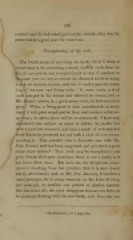Page 442 - My FlipBook
P. 442
438
enamel, and the individual particularly cleanly, they may be
preserved in a good state for some time.
Transplanting of the teeth.
The fourth mode of replacing the teeth which I think of
mentioning is, by extracting a sound, healthy tooth from the
jaw of one person and transplanting it to that of another ; at
the same time we are to extract the diseased tooth or stump
which we wish to replace, and into its socket pass the warm
fang of the new and living tooth. In some cases, a dead
tooth was put in the socket and allowed to remain, and, as
Mr. Hunter asserts, in a great many cases, he had seen these
grow. When a living tooth is thus transplanted, in many
cases, it will grow sound and be firm, and continue so for ma-
ny years ; in others, there will be no union at all. I have only
introduced this subject in order to inform the reader that
such a case has occurred, and such a mode of restoring lost
teeth has been practiced, but not with a view of ever recom-
mending it. This practice was a favourite one with Mr.
John Hunter, and had been suggested and practiced a great
many years before.* That teeth may be transplanted and
grow firm in their new situations, there is not a doubt, as it
has been often done. But such are the dangerous conse-
quences resulting from this practice, that it is now almost
wholly abandoned ; and, as Mr. Fox observes, it involves a
moral principle, for it seems contrary to the laws of every
just principle, to mutilate one person to perfect another.
But this is not all ; the most dangerous diseases are liable to
be propagated along with the new tooth, and, from this rea-
" See Fauchard, vol. I, page 383.


